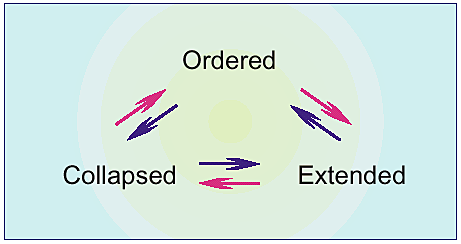
The protein trinity—linking function and disorder
- Select a language for the TTS:
- UK English Female
- UK English Male
- US English Female
- US English Male
- Australian Female
- Australian Male
- Language selected: (auto detect) - EN
Play all audios:

Access through your institution Buy or subscribe Interpreting function in terms of specific three-dimensional structure has dominated thinking about proteins for more than 100 years,
starting with the lock-and-key proposal of Fischer1 and continuing with the equating of denaturation with loss of specific structure by Wu2 and independently at a slightly later date by
Mirsky and Pauling3. This dependence of function on structure is even embedded in our language: unfolded protein and denatured protein are used interchangeably. Furthermore, the avalanche of
protein three-dimensional structures determined by X-ray diffraction and by nuclear magnetic resonance (NMR)4 has diverted attention away from alternative views. Numerous counterexample
proteins have surfaced over the years—proteins for which lack of three-dimensional structure is required for function. One clear example is calcineurin, a serine/threonine phosphatase that
becomes activated by the binding of the Ca2+–calmodulin complex to a region that exists as a disordered ensemble5,6. The disorder spans the calmodulin binding site and is essential for
calcineurin function. That is, when calmodulin binds to its target helix, the helix becomes completely surrounded7. Thus, the open, flexible disordered region of calcineurin provides the
space needed by calmodulin so it can completely surround its target helix. This is a preview of subscription content, access via your institution ACCESS OPTIONS Access through your
institution Subscribe to this journal Receive 12 print issues and online access $209.00 per year only $17.42 per issue Learn more Buy this article * Purchase on SpringerLink * Instant access
to full article PDF Buy now Prices may be subject to local taxes which are calculated during checkout ADDITIONAL ACCESS OPTIONS: * Log in * Learn about institutional subscriptions * Read
our FAQs * Contact customer support REFERENCES * Fischer, E. _Ber. Dt. Chem. Ges._ 27, 2985–2993 (1894). Article CAS Google Scholar * Wu, H. _Chinese J. Physiol._ 1, 219–234 (1931).
Google Scholar * Mirsky, A.E. & Pauling, L. _Proc. Natl. Acad. Sci. USA_ 22, 439–447 (1936). Article CAS Google Scholar * Berman, H.M. et al. _Nucleic Acids Res._ 28, 235–242 (2000).
Article CAS Google Scholar * Manalan, A.S. & Klee, C.B. _Proc. Natl. Acad. Sci. USA_ 80, 4291–4295 (1983). Article CAS Google Scholar * Kissinger, C.R. et al. _Nature_ 378,
641–644 (1995). Article CAS Google Scholar * Meador, W.E., Means, A.R. & Quiocho, F.A. _Science_ 257, 1251–1255 (1992). Article CAS Google Scholar * Wright, P.E. & Dyson, H.J.
_J. Mol. Biol._ 293, 321–331 (1999). Article CAS Google Scholar * Dunker, A.K. et al. _J. Mol. Graphics Modeling_ 19, 26–59 (2001). Article CAS Google Scholar * Namba, K. _Genes Cells_
6, 1–12 (2001). Article CAS Google Scholar * Romero, P., Obradovic, Z., Kissinger, C.R., Villafranca, J.E. & Dunker, A.K. _Proc. I.E.E.E. International Conference on Neural Networks_
1, 90–95 (1997). CAS Google Scholar * Vucetic, S., Radivojac, P., Brown, C.J., Dunker, A.K. & Obradovic, Z. _Methods for improving protein disorder prediction_. Proc. International
Joint INNS-IEEE Conference on Neural Networks, Washington, DC 4, 2718–2723 (2001). Google Scholar * Iakoucheva, L.M. et al. _Protein Sci._ 10, 560–571 (2001). Article CAS Google Scholar
* Dunker, A.K., Obradovic, Z., Romero, P., Garner, E.C. & Brown, C.J. _Genome Informat._ 11, 161–171 (2000). CAS Google Scholar * Schulz, G.E. In _Molecular mechanism of biological
recognition_. (ed. Balaban, M.) 79–94 (Elsevier/North-Holland Biomedical Press, New York, NY; 1979). Google Scholar * Kriwacki, R.W., Hengst, L., Tennant, L., Reed, S.I. & Wright, P.E.
_Proc. Natl. Acad. Sci. USA_ 93, 11504–11509 (1996). Article CAS Google Scholar * Jeong, H., Mason, S.P., Barabasi, A.L. & Oltvai, Z.N. _Nature_ 411, 41–42 (2001). Article CAS
Google Scholar * Reeves, R. _Genes_, in press (2001). * Huth, J.R. et al. _Nat. Struct. Biol._ 4, 657–665 (1997). Article CAS Google Scholar Download references AUTHOR INFORMATION
AUTHORS AND AFFILIATIONS * professor of biophysics at the School of Molecular Biosciences, Washington State University, Pullman, 99124, WA A. Keith Dunker * professor and director at the
Center for Information, Science and Technology, Temple University, Philadelphia, 19122, PA Zoran Obradovic Authors * A. Keith Dunker View author publications You can also search for this
author inPubMed Google Scholar * Zoran Obradovic View author publications You can also search for this author inPubMed Google Scholar RIGHTS AND PERMISSIONS Reprints and permissions ABOUT
THIS ARTICLE CITE THIS ARTICLE Dunker, A., Obradovic, Z. The protein trinity—linking function and disorder. _Nat Biotechnol_ 19, 805–806 (2001). https://doi.org/10.1038/nbt0901-805 Download
citation * Issue Date: September 2001 * DOI: https://doi.org/10.1038/nbt0901-805 SHARE THIS ARTICLE Anyone you share the following link with will be able to read this content: Get shareable
link Sorry, a shareable link is not currently available for this article. Copy to clipboard Provided by the Springer Nature SharedIt content-sharing initiative
